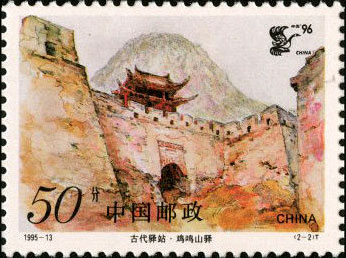
the Great Wall of China is a long stretch of all right across the Northern part of China. It was built to protect China and to keep the enemies out of China.
We visited this ancient courier office established probably during the Sptring and Autumn and Warring States Period (700- 220BC). But it was during the Yuan Dynasty (1271-1368) that the first documents were found to describe westward military expeditions and constructions of post road. It was the Yuan Dynasty's emperors' raod to Xanadu and Dadu (present Beijing) via Changping and Huailai.
 Courier stations played an important role in Chinese history. In ancient times, posthorses were used to send messages and deliver official documents. Horses had to be refreshed and changed hence many horse posts were set up. They evolved into courier stations where officials and merchants found accomodation. These posts also functioned as military strongholds.
Courier stations played an important role in Chinese history. In ancient times, posthorses were used to send messages and deliver official documents. Horses had to be refreshed and changed hence many horse posts were set up. They evolved into courier stations where officials and merchants found accomodation. These posts also functioned as military strongholds.The Chinese word for courier station actually has the word horse on the left side.
This site was badly ruined over time but in recent years, the Chinese government started to renovate it and now it is receiving the largest number of tourists visiting the Great Wall of China.
Established at the foot of the Jiming Mountain, northwest of Huailai county, Hebei Province, this courier station is today a modern tourist site. This was my first visit to Northern China, and Hebei.
According to all the modern accounts, Jiming Courier Station is the best preserved and largest existing courier station in China.
During the Ming Dynasty, the Courier Station was expanded making it the first large scale post house from Xuanhua prefecture to the Capital. In 1570, supervised by Wang Maochang, a defence commander, the bounding wall was constructed with bricks, which was 2,330 metres (m) in circumference, 11.7 m in height, over 400 m in side length and 200,000 square metres in floor area.
During Emperor Kangxi's reign (1662–1723) of the Qing Dynasty, an assistant officer was designated in charge of the courier station's affairs. A total of 158 soldiers were deployed, including 43 soldiers stationed inside, 45 officers and 49 postal servicemen. The courier station was supplied with 82 horses whose planned annual consumption of fodder was 44 dan (a unit of dry measure for grain, one dan equivalent to 100 litres) and monthly consumption of rice was 493.2 dan. Three thousand two hundred and eighty-seven taels of silver were earmarked for the courier station every year. It was a major transfer station from Beijing to north-west areas.



No comments:
Post a Comment